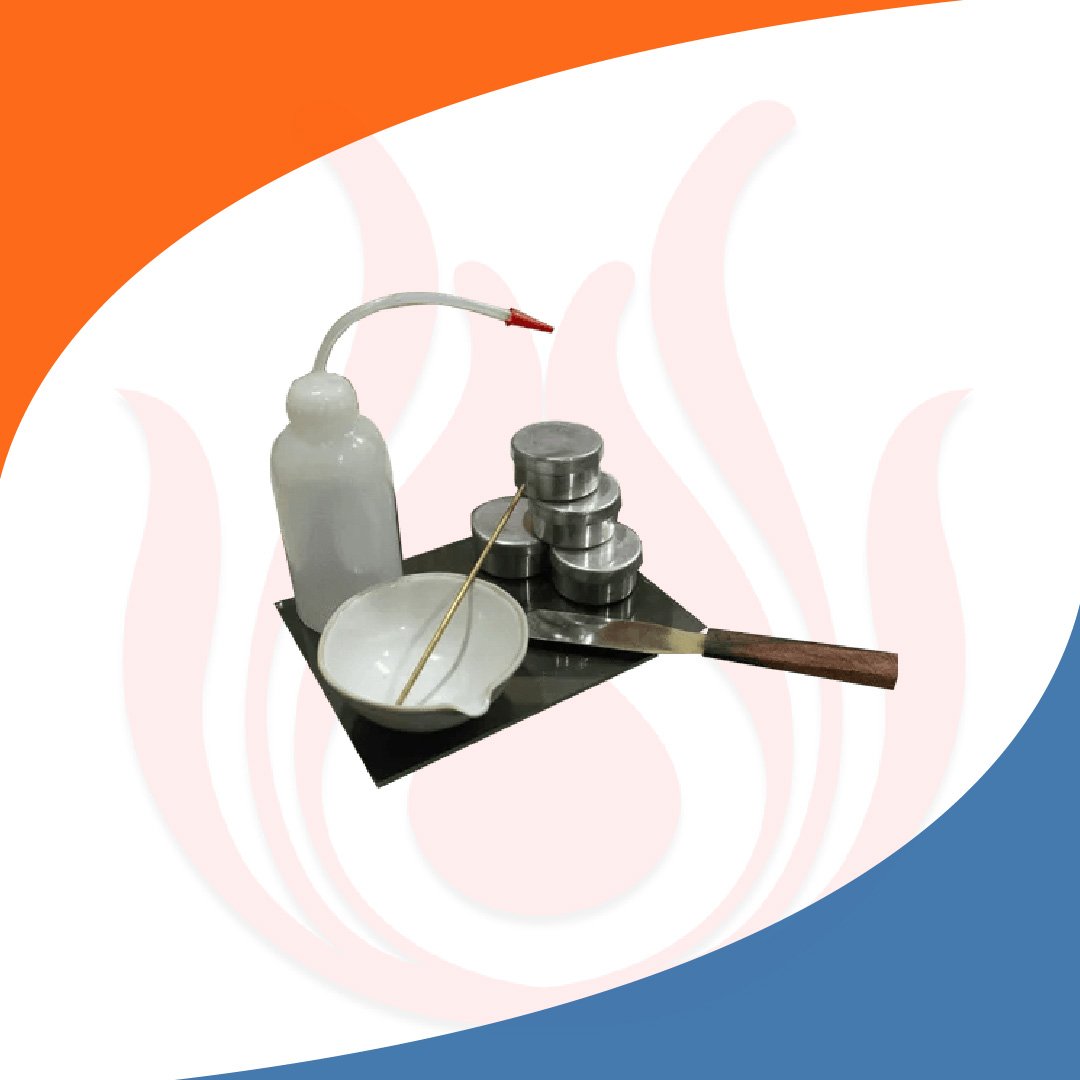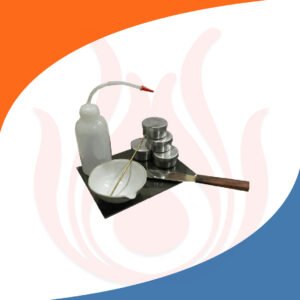Plastic Limit Set
- High Quality Materials
- Compliance With Standards
- Clear Product Information
- Warranty & Support
- Product Testing & Certification
- Delivery & Policy
- Ask a Question
- Estimated Delivery: 5 Days – 10 Days
- DESCRIPTION
FEATURE | SPECIFICATION |
Size | 500 x 500 x 10mm |
Set of moisture containers | 6 |
Case Material | Wood |
Plastic wash bottle | 500ml |
Flexible Spatula | 15cm |
Porcelain basin | 150 mm dia |
Information About Liquid Limit Set:
Plastic limit.
INTRODUCTION
The plastic limit refers to the maximum degree tolerance where a material can be pushed beyond being semi-solid and becomes plastique. This concept is essential in geotechnical engineering to evaluate the behaviour of fine-grained soils, for example clays.
It is the water content beyond which a soil cannot be rolled into thread of certain diameter without breaking apart. When these boundaries are surpassed, the soil further loses its capability of deformation without cracking or fracturing. Its use of plastic limit sets helps the engineers to get its value for soil classification and foundation behaviour prediction. This critical indicator is of great importance in the construction world since it affects decisions with regard to digging, compaction and slope stability.
KEY FEATURES
Versatility: Therefore, plastic limit sets provide the required versatility in different laboratory tests and are an essential instrument of soil mechanics and geotechnical engineering.
Precision Measurement: These sets facilitate an accurate determination of the plastic limit which is a key parameter in understanding soil response to certain situations.
Consistency Testing: They provide standardized, repeatable testing processes that guarantee accurate soil plasticity measurements.
Ease of Use: The design of plastic limit sets is made easy to use, which allows technicians and engineers carry out tests in an efficient manner.
Standard Compliance: These sets follow established industry standards, thus ensuring compatibility with standardized testing protocols.
Durable Construction: Featuring durable construction, plastic limit sets are made to be used often and hence their durability is related to the fact that they can withstand frequent use.
Accurate Sample Preparation: The sets consist of elements that facilitate preparation and soil samples, thus minimizing mistakes in testing.
UNDERSTANDING THE WORKING PROCEDURE
Plastic limit of soil is the important parameter in geotechnical engineering which describes its plasticity. The plastic limit test is done by adding water to a soil sample until it becomes agreeable through manufacture of thread with criteria diameter without breakage.
The process entails air-drying a representative soil sample, crumbling it into pieces and then slowly adding water while kneading the soil. This process continues up to the point where soil just begins plastic behaviour. At this moisture content, the plastic limit is reached.
This technique allows estimating the concentration of clay and its plasticity criterion, enabling categorization and comprehension of soils’ engineering features. The plastic limit test is a standardized procedure which ensures the uniformity in classification of soil for building and environmental uses.
USAGE AND APPLICATION
The plastic limit is a significant parameter in geotechnical engineering that describes the moisture content at which soil changes its state from being regular to semisolid. This limitation is critical in determining the nature of soil behaviour and designing foundations.
The plastic limit helps engineers to calculate the clayey or silty index, aiding technicians in classifying soils as either of these. Stability and problems with settlement are avoided during construction projects using such information for proper foundation design. In addition, the plastic limit is essential to Atterberg limits units along with liquid and shrinkage.
This system helps to assess water properties of soils and the adaptability for different uses. Soil stability, excavation needs and settlement possibilities are determined based on plastic limit data used by geotechnical investigations. In conclusion, the plastic limit is used in foundation design soil classification and for geotechnical evaluation contributing greatly towards making all erections successful and safe.
ADVANTAGE AND BENEFIT
The plastic limit is an important parameter in geotechnical engineering that shows the maximum moisture content at which a soil changes from plastic to semi-solid condition. However, its benefits and advantages in construction and soil mechanics are enormous. Initially, it assists in evaluating the plasticity index which is one of the soil classification parameters.
This data assists engineers in evaluating soil characteristics for building projects to determine proper foundation design and stability. In addition, the plastic limit allows determining shrink-swell potential of a soil to avoid problems such as settlement or heaving under development structures. It also helps control the management of soil moisture during construction, preventing problems such as too much settlement due to poor compaction.
CONCLUSION
The plastic limit which is very important in geotechnical engineering refers to the moisture content at which a soil changes from being plastic to semi solid. This boundary helps in explaining soil behaviour. Noting that the plastic limit should not exceed 140 words, controlling moisture is crucial for stability in these undertakings.
If the limit of plasticity is surpassed, structural problems may arise with regard to foundations and general integration. There is a need to ensure careful control of moisture during the construction process in order for engineers to have ideal soil conditions. Secondly, compliance with prescribed plastic limits is crucial for preventing soil instability and protecting structures while keeping engineering projects sustainable over time.
Plastic limit refers to the moisture content at which a soil changes from being plastic state into that of semisolid type.
It is used to establish soil characteristics in construction wherein how much water a given soil can hold without turning into an overly soggy condition.
Mostly, it is determined using the method of Casagrande that includes rolling soil into threads with predetermined diameters.
However, passing the plastic limit can cause instability and affect soil’s load-bearing ability leading to a decrease in construction integrity.
Appropriate investigation, soil testing and engineering provisions can help control the challenges that arise during construction as a result.
















